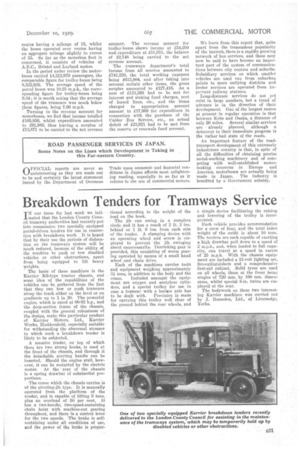Breakdown Tenders for Tramways Service
Page 67

If you've noticed an error in this article please click here to report it so we can fix it.
IN our issue for last week we inti'mated that the London County Council tramway authorities had recently put into' commission two specially equipped petrol-driven tenders for use in connection with breakdown, work. It is hoped that by their use the periods of dislocation on the tramways system will be much. reduced, because of the ability of the machine to push or tow disabled vehicles or other obstructions, apart from being equipped to lift heavy weights.
The basis of these machines is the Karrier K6-type tractor chassis, and some idea 'of the 'capabilities of the vehieles can be gathered from the fact that they can tow or push tramcars along the track either on the level or on gradients up to 1 in 20The powerful engine, which is rated at 60-82 b.p., and. the deep-section frame of the chassis, coupled with the general robustness of the design, make this particular product of Karrier Motors, Ltd., Karrier Works, Huddersfield, especially suitable for withstanding the abnormal stresses to which such a breakdown tender is likely to be subjected.
A massive fender, on top of which there are two strong hooks, is used at the front of the chassis, and through it the detachable starting handle can be inserted. Should the engine stall, however, it can be restarted by the electric motor. At the 'rear of the chassis is a spring drawbar of substantial proportions. , The crane which the chassis carries is of the pivoting-jib type.. It is manually operated from the platform of the tender, and is capable of lifting 5 tons, plus an overload of 50 per cent. it has a two-handle, two-speed-sustaining chain hoist with machine-cut gearing throughout, and there is a control lever for the two speeds. The brake is selfsustaining under all conditions of use, and the power of the brake is propor
tinned according to the weight of the load on the hook.
The jib can swing. in a complete circle and it has a reach of 2 ft. 3 ins, behind or 1 ft. 9 ill& from each side of the tender. A clamping device with an operating wheel and screw is employed to prevent the jib swinging about unnecessarily. Derricking gear is provided, this consisting of worm gearing operated by means of a small hand wheel and chain drive.
Each of the machines carries tools and equipment weighing approximately 31 tons, in addition to the body and the
crane. Included amongst the equipment are oxygen and acetylene cylinders, and a special trolley for use in case a tramcar with a brolaen axle has
to be dealt with. Provision is made for carrying this trolley well clear of the ground behind the rear wheels, and a simple device facilitating the raising and lowering of the trolley is incorporated.
Each vehicle provides accommodation for a crew of four, and the total laden weight of the outfit is about 10 tons., The tenders are each capable of exerting a high drawbar pull down to a speed of 2 m.p.h., and, when loaded to full capacity, can travel at a speed in excess of 25 m.p.h. With the chassis equipment are included a 12-volt lighting set, fire-extinguishers and a comprehensive first-aid cabinet. Solid tyres are used on all wheels, those at the front being singles of 720 ram. by 160 mm. dimensions, whilst special 8-in, twins are em
ployed at the rear. • The bodywork on these two interesting Karrier machines was carried out by J. Ramsden, Ltd., of Liversedge, Yorks.
























































































































